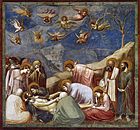- Figurative art
-
 Kenyon Cox, Nude study, 1896, Kenyon Cox was a strong advocate of figurative art.
Kenyon Cox, Nude study, 1896, Kenyon Cox was a strong advocate of figurative art.
Figurative art, sometimes written as figurativism, describes artwork—particularly paintings and sculptures—which are clearly derived from real object sources, and are therefore by definition representational.
Contents
Definition
The term "figurative art" is often taken to mean art which represents the human figure, or even an animal figure, and, though this is often the case, it is not necessarily so:
Since the arrival of abstract art the term figurative has been used to refer to any form of modern art that retains strong references to the real world.—[1]Painting and sculpture can therefore be divided into the categories of figurative, representational and abstract, although, strictly speaking, abstract art is derived (or abstracted) from a figurative or other natural source. However, the term is sometimes used as a synonym for non-representational art and non-objective art, i.e. art which has no derivation from figures or objects.
Formal elements
The formal elements, those aesthetic effects created by design, upon which figurative art is dependent, include line, shape, color, light and dark, mass, volume, texture, and perspective,[2] although it should be pointed out that these elements of design could also play a role in creating other types of imagery -- for instance abstract, or non-representational or non-objective two-dimensional artwork. The difference is that in figurative art these elements are deployed to create an impression or illusion of form and space, and, usually, to create emphasis in the narrative portrayed.
Evolution
Figurative art is itself based upon a tacit understanding of abstracted shapes: the figure sculpture of Greek antiquity was not naturalistic, for its forms were idealized and geometric.[3] Ernst Gombrich referred to the strictures of this schematic imagery, the adherence to that which was already known, rather than that which is seen, as the "Egyptian method", an allusion to the memory-based clarity of imagery in Egyptian art.[4]
Eventually idealization gave way to observation, and a figurative art which balanced ideal geometry with greater realism was seen in Classical sculpture by 480 B.C.[3] The Greeks referred to the reliance on visual observation as mimesis. Until the time of the Impressionists, figurative art was characterized by attempts to reconcile these opposing principles.[4]
From the early Renaissance, Mannerism and the Baroque through 18th, 19th and 20th century painting Figurative art has steadily broadened its parameters. Nicolas Poussin (1594-1665), a French painter in the classical style whose work predominantly features clarity, logic, and order, and favors line over color; served as an alternative to the more narrative Baroque style of the 17th century. He was a major inspiration for such classically-oriented artists as Jacques-Louis David, Jean-Auguste-Dominique Ingres and Paul Cézanne. The rise of the Neoclassical art of Jacques-Louis David ultimately engendered the realistic reactions of Gustave Courbet and Édouard Manet leading to the multi-faceted figurative art of the 20th century.
Gallery
-
Kamāl ud-Dīn Behzād, The construction of castle Khornaq, in al-Hira, c. 1494-1495
-
Giotto, The Lamentation, c. 1305, Scrovegni Chapel
-
El Greco, The Opening of the Fifth Seal 1608-1614, Metropolitan Museum of Art, New York City
-
Peter Paul Rubens, Judgement of Paris, c. 1636, National Gallery, London
-
Nicolas Poussin, Et in Arcadia ego (Les Bergers d’Arcadie), late 1630s, the Louvre
-
Jean Auguste Dominique Ingres, The Valpinçon Bather, 1808, the Louvre
-
Eugène Delacroix, The Barque of Dante, 1822, the Louvre
-
Gustave Courbet, A Burial at Ornans, 1849-1850, Musee d'Orsay, Paris
-
Édouard Manet, The Old Musician, 1862, National Gallery of Art Washington, DC
-
Edgar Degas, Ballet Rehearsal, 1873, The Fogg Art Museum, Cambridge, Massachusetts
-
Pierre-Auguste Renoir, Dance at Le Moulin de la Galette (Bal du moulin de la Galette), 1876, Musée d'Orsay
-
Thomas Eakins, The Swimming Hole, 1884-5, Amon Carter Museum, Fort Worth, Texas
-
Paul Cézanne, Bather, 1885-1887, Museum of Modern Art
-
Paul Gauguin, The Midday Nap, (1894)
-
John French Sloan, McSorley's Bar, 1912, Detroit Institute of Arts
-
George Bellows, Dempsey and Firpo (1924), Whitney Museum of American Art
-
Edward Hopper, Tables for Ladies, 1930
See also
- Abstract art
- Illustration
- Neofigurative Art
- Stuckism
- Abstract figurative
Notes and references
- ^ "Glossary: Figurative", Tate. Retrieved 7 April 2006
- ^ Adams, Laurie Schneider, The Methodologies of Art, pages 17-19. Westview Press, 1996,
- ^ a b Clark, Kenneth, The Nude: A Study in Ideal Form, pages 31-2. Princeton University Press, 1990.
- ^ a b The Gombrich Archive: Press statement on The Story of Art
External links
Categories:
Wikimedia Foundation. 2010.
























